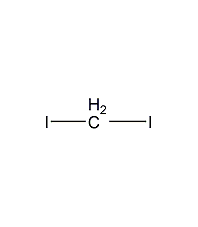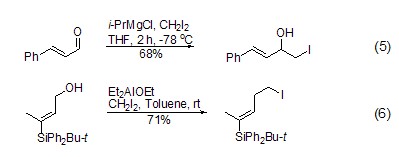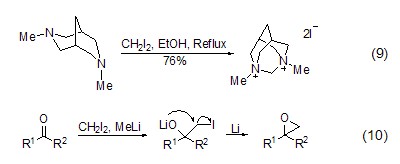
Structural formula
| Business number | 01J0 |
|---|---|
| Molecular formula | CH2I2 |
| Molecular weight | 267.84 |
| label |
methylene iodide, methine iodide, methylene diiodide, methylene iodide, Methylene iodide, Methylene diodide, Aliphatic halogenated derivatives |
Numbering system
CAS number:75-11-6
MDL number:MFCD00001079
EINECS number:200-841-5
RTECS number:PA8575000
BRN number:1696892
PubChem number:24849735
Physical property data
1. Properties: colorless clear to light yellow liquid. [14]
2. Melting point (℃): 5~6[15]
3. Boiling point (℃) : 181 (decomposition) [16]
4. Relative density (water = 1): 3.32[17]
5. Relative vapor density (air = 1): 9.25[18]
6. Heat of combustion (kJ/mol): -745.7[19]
7. Critical pressure (MPa): 5.47[20]
8. Octanol/water partition coefficient: 2.3[21]
9. Flash point (℃): 110[22]
10. Solubility: insoluble in water, soluble in ethanol, Most organic solvents such as ether, benzene, and chloroform. [23]
11. Refractive index at room temperature (n20): 1.7411
12. Refractive index at room temperature (n25): 1.7380
13. Solubility parameter (J·cm-3)0.5: 24.055
14.van der Waals area (cm2·mol-1): 6.430×109
15. van der Waals volume (cm3·mol-1): 50.930
16. Viscosity (10ºC): 3.35mPa. s
17. Liquid phase standard claimed heat (enthalpy) (kJ·mol-1): 67.8
18. Liquid phase standard hot melt (J ·mol-1·K-1): 135.5
19. The gas phase standard claims heat (enthalpy) (kJ·mol-1 ): 118.7
20. Gas phase standard entropy (J·mol-1·K-1): 309.50
21. Gas phase standard formation free energy (kJ·mol-1): 101.7
22. Gas phase standard hot melt (J·mol-1 sup>·K-1): 57.73
Toxicological data
1. Acute toxicity
Children’s oral LDLO: 2778 uL/kg
Rat abdominal LD50: 403mg/kg
Mouse abdominal LD50: 467mg /kg
Mouse subcutaneous LD50: 830mg/kg
2. Acute toxicity[24] LD50: 403mg/kg (rat oral); 830mg/kg (rat transdermal)
3. Irritation No data available
4. Mutagenicity [25] Microbial mutagenicity: Escherichia coli 3mg/dish.
Ecological data
1. Ecotoxicity No data available
2. Biodegradability No data available
3. Non-biodegradability No information yet
4. Other harmful effects This substance is harmful to the environment and attention should be paid to atmospheric pollution. [26]
Molecular structure data
1. Molar refractive index: 32.62
2. Molar volume (cm3/mol): 82.6
3. Isotonic specific volume (90.2K ): 219.9
4. Surface tension (dyne/cm): 50.0
5. Polarizability (10-24cm3): 12.93
Compute chemical data
1. Reference value for hydrophobic parameter calculation (XlogP): 2.3
2. Number of hydrogen bond donors: 0
3. Number of hydrogen bond acceptors: 0
4. Number of rotatable chemical bonds: 0
5. Number of tautomers:
6. Topological molecular polar surface area (TPSA): 0
7. Number of heavy atoms: 3
8. Surface charge: 0
9. Complexity: 2.8
10. Number of isotope atoms: 0
11. Determine the number of atomic stereocenters: 0
12. Uncertain number of atomic stereocenters: 0
13. Determine the number of chemical bond stereocenters Number: 0
14. Number of uncertain chemical bond stereocenters: 0
15. Number of covalent bond units: 1
Properties and stability
1. Toxic. Less anesthetic than methylene bromide.
2. Cause headache and difficulty breathing after smelling it. See Dibromomethane.
3. Storing it with copper powder can effectively prevent its decomposition; care should be taken to protect it from light; it cannot coexist with many metals (such as Al, Mg, Na, etc.) and strong alkali; there is certain corrosion safety; operate in a fume hood.
4. Stability[27] Stable
5. Incompatible substances[28] Strong oxidants, strong bases, alkali metals
6. Conditions to avoid contact[29] Heat and light
7. Polymerization hazard[30] No polymerization
8. Decomposition products[31] Iodide
Storage method
Storage Precautions[32] Store in a cool, ventilated warehouse. Keep away from fire and heat sources. Keep container tightly sealed. They should be stored separately from oxidants, alkalis, alkali metals, and food chemicals, and avoid mixed storage. Equipped with the appropriate variety and quantity of fire equipment. The storage area should be equipped with emergency release equipment and suitable containment materials.
Synthesis method
1. The iodoform and sodium arsenite method first uses arsenic trioxide and liquid alkali to react to prepare sodium arsenite, then mix the iodoform and sodium arsenite solutions, heat to 60~65°C with stirring, and then Add sodium hydroxide to produce diiodomethane in a one-step reaction. The reaction product is washed with water, distilled, decolorized, crystallized, separated and dried to obtain the finished product. 
2. The effect of iodoform method and sodium acetate The reaction formula is as follows:
After the above reaction is completed, The finished product is obtained by distillation.
3. The phase transfer catalytic synthesis method uses triethylbenzyl ammonium chloride as the catalyst and is obtained by the reaction of dichloromethane and sodium iodide. The reaction formula is as follows:
Purpose
1. Organic synthetic raw materials, chemical reagents and pharmaceutical intermediates can be used to manufacture X-ray contrast agents, determine mineral density and refractive index, and separate minerals, etc.
2. Diiodomethane is a methylene transfer reagent that can react with different metals or alkyl metals to form carbenes, undergo cyclopropanation reactions with alkenes, and can also react with carbonyl groups to form methylene groups. chemical reaction. At the same time, nucleophiles such as ICH2M and I2CHM can also be prepared, and can also participate in free radical coupling reactions.
Methylene Many carbonyl methylation reagents use diiodomethane as the carbon source, which can be used as an alternative to the Wittig reaction; in the presence of ketones, diiodomethane The reaction of methane and magnesium amalgam can produce olefins (formula 1) in high yields[1]. This reaction can occur with aldehydes and ketones of different structures.

The presence of Lewis acid can greatly Accelerate the reaction and improve the selectivity and yield of the reaction. Commonly used Lewis acids include trimethylaluminum, titanium tetraisopropoxide, titanium tetrachloride, di(cyclopentadienyl)zirconium dichloride, etc. Among them, CH2I2/Zn/ Me3Al and CH2Br2/Zn/TiCl4The two groups of reagents have the best effect. In the presence of ketones, aldehydes can selectively undergo methylation reactions (Formula 2)[2].

Cyclopropanation In organic synthesis, diiodomethane is mainly used to carry out cyclopropanation reactions involving metals. The most important is zinc-involved cyclopropanation (Simmons-Smith reaction), a reagent that is widely used and capable of many variations. ZincThe source is crucial to the success or failure of the reaction. Zn/Cu, diethyl zinc, etc. can be used as sources of Zn for cyclopropanation reaction. Diiodomethane and samarium mercury or samarium iodide can be combined to obtain many different samarium-containing olefin cyclopropanation reagents, all of which can react with allyl alcohol and enol. α,β-unsaturated esters and α,β-unsaturated amides can also be combined with samarium catalysis Diiodomethane undergoes cyclopropanation reaction (Formula 3)[3]. The cyclopropanation reactions of zinc-containing reagents and samarium-containing reagents are directly affected by hydroxyl groups [4]. Treating diiodomethane with trialkyl aluminum (such as triisobutylaluminum) will also give the corresponding cyclopropane, which is a good complement to the zinc and samarium system. This reaction tends to react with independent alkenes, while It does not react with allyl alcohol (Formula 4)[5].

'ICHNucleophilic addition of 2' Methyl iodide prepared from samarium metal [6] can react with aldehydes, ketones and enones, and magnesium reagents can also be used For this reaction (Equation 5)[7]. The aluminum reagent can also be used to replace the allyl alcohol hydroxyl group with iodomethyl, Et3Al, Et2AlCl, Et2AlOEt All can participate in this reaction (such as equation 6)[8].

|
(+)-trans-(2S,3S)-bis(diphenylphosphine)bicyclo[2.2.1]hept-5-ene |
Nucleophilic addition of 'I2CH' CH2I2 deprotonates under the action of a base After oxidation, I2CHM derivatives are obtained. These compounds are more stable than the corresponding ICH2M and can react with many electrophiles[9]. Commonly used bases include Cy2NLi, NaHMDS, LiHMDS and LDA. Allyl iodide is synthesized using I2CHLi. First treat diiodomethane with LiHMDS, then add sulfone, and evaporate the water to obtain allyl iodide, but the selectivity is relatively poor (Formula 7)[9].

Free radical addition Addition of ICH2 fragments to α,β-unsaturated ketones in the presence of triethylborane Reaction to obtainγ-iodoketone (formula 8)[10]. The intermediate boron enolate can be either hydrolyzed or alkylated.

Alkylation reaction The application of diiodomethane in alkylation is limited. ClCH2I and ClCH2Br are more prone to alkylation reactions than diiodomethane, but , diiodomethane can be used in cycloalkylation reactions. Diamine can react with diiodomethane. Slowly adding diiodomethane solution to the diamine solution can obtain a higher yield (Formula 9)[11]. In the reaction with Pt as a catalyst, diiodomethane reacts with thiol to obtain dithiane[12]. In addition, the in-situ generation of iodomethyllithium in the presence of diiodomethane and alkyl lithium can easily and quickly convert many carbonyl compounds into epoxides (Formula 10)[13].

3. Used in organic synthesis and Separation of mixed minerals. [33]
extended-reading:https://www.newtopchem.com/archives/1763extended-reading:https://www.bdmaee.net/wp-content/uploads/2022/08/134-2.jpgextended-reading:https://www.bdmaee.net/dabco-mp602-delayed-amine-catalyst-non-emission-amine-catalyst/extended-reading:https://www.bdmaee.net/polyurethane-sealer-ba100-delayed-catalyst-ba100-polyurethane-sealing-agent/extended-reading:https://www.newtopchem.com/archives/1141extended-reading:https://www.cyclohexylamine.net/dmcha-cas-98-94-2-n-dimethylcyclohexylamine/extended-reading:https://www.bdmaee.net/wp-content/uploads/2022/08/Tributyltin-chloride-CAS1461-22-9-tri-n-butyltin-chloride.pdfextended-reading:https://www.newtopchem.com/archives/category/products/page/30extended-reading:https://www.bdmaee.net/butyltin-chloride/extended-reading:https://www.newtopchem.com/archives/696


Comments